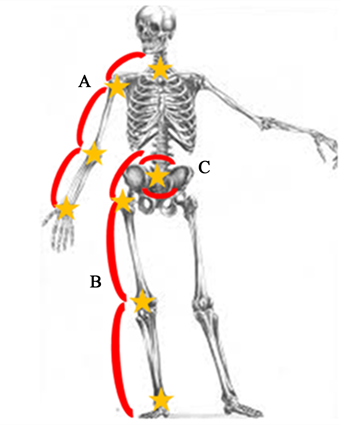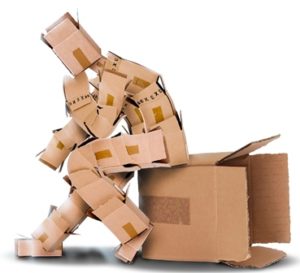“Deme Bones” – Regional interdependence

The common reframe from the old spiritual song “dem bones” is the “toe bone is connected to foot bone”.
In the medical community this concept of mechanical connectiveness is referred to as “regional interdependence”. Regional interdependence is seemingly unrelated impairments in remote anatomical regions of the body may contribute to and be associated with a patient’s primary report of symptoms.

Illustration of Regional Interdependence – Luca Collegrusco 2016
The following are a few examples of the concept of regional interdependence.
K.M. Berglund showed restrictions in thoracic spine movements are correlated with tennis elbow pain. The mechanical influence can be from spine out to extremities – spine bone connected to arm bone.
Stupar published association between low back pain and osteoarthritis of the hip and knee.
Kosahvili showed a correlation with pronation of the foot contributing to knee pain &/or back pain. The mechanical influenced can be from extremity up the leg to the spine – leg bone connected to spine bone.
LA Feigenbaum provides evidence that right-handed baseball pitchers shoulder pain can be related to left big toe problems. The mechanical influence can cross the mid-line of the body.
H.J. Dananberg shows how limited big to motion can be contributing factor to back pain.
Why is it important to remember the reframe of “deme bones”?
Orthopedic surgery has become highly specialized. Some orthopedic surgeons have narrowed their practice to one joint and sometimes to just one surgical procedure for that one joint. This type of specialization has advantages of superior surgical procedures. This type of specialization creates a challenge for the surgeon to address problems that involve more than one joint. Specialist need to remember “if all you have is hammer the whole world looks like nails”. Mindfulness of the concept of regional interdependence may help avoid risky invasive medical procedures. Reputable healthcare professionals ask for consultations &/or make referrals to more appropriate healthcare professional.
There are times when despite appropriate standard of care for musculoskeletal problems the results are not good enough. Looking “out of the box” or looking up and down the body can provide significant benefit. For example older individuals with spinal stenosis (osteoarthritis of spine) will experience back and perhaps leg pain. They will have limited ability to stand up straight or walk for longer periods of time. The results of medications, injections, back brace, traditional physical therapy has results which are not good enough. And, surgery may not be an option. Looking at adjacent joints in the upper back, the hip, and the ankle may provide opportunities. If the lumbar spine is in very bad shape, improving the flexibility, strengthen and stability of the neighbor joints can help. In addition, caloric control and designing pain free exercise to decrease body weight (abdominal fat) can help.

Thinking Outside of the Box
Applying the concept of regional interdependence in the diagnosis and treatment decision process can result in less clinical visits and less cost.
Applying the concept of “deme bones” or regional interdependence assures a more thorough holistic approach to solving musculoskeletal pain syndromes.
A musculoskeletal pain may not need a hammer and nail to stabilize and relieve pain. It may benefit from a screwdriver and screw or wrench and bolt.
Even though one body region may be the source of pain, strengthening and mobilizing other areas may be helpful if not necessary for the condition to improve. This can be tricky to figure out on your own. Going to see Dr. Google can solve problems. Dr. Google has a tough time individualizing self-treatment. So, if you’re having ongoing pain or difficulty moving the way you want to, it’s helpful to see a Physical Therapist who knows how to assess and address these problems.
Damien Howell Physical Therapy – 804-647-9499 – Fax: 866-879-8591 At-Home, At Office, At Fitness Facility – I come to you, I do home visits Damien@damienhowellpt.com
